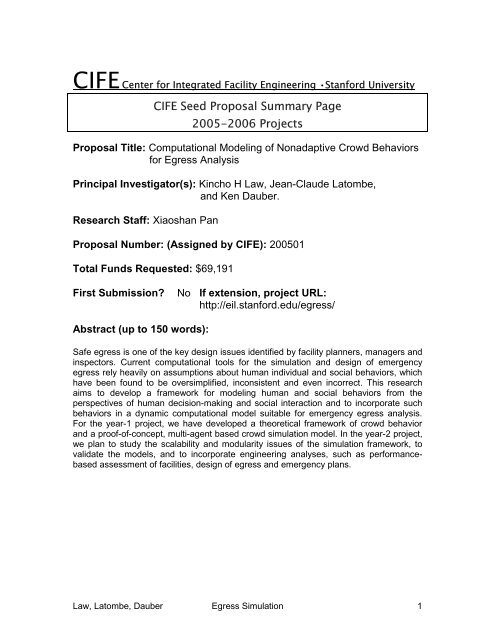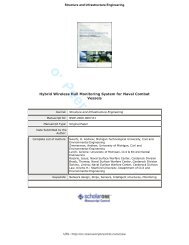Research Proposal - Engineering Informatics Group - Stanford ...
Research Proposal - Engineering Informatics Group - Stanford ...
Research Proposal - Engineering Informatics Group - Stanford ...
Create successful ePaper yourself
Turn your PDF publications into a flip-book with our unique Google optimized e-Paper software.
CIFE Center for Integrated Facility <strong>Engineering</strong> •<strong>Stanford</strong> University<br />
CIFE Seed <strong>Proposal</strong> Summary Page<br />
2005-2006 Projects<br />
<strong>Proposal</strong> Title: Computational Modeling of Nonadaptive Crowd Behaviors<br />
for Egress Analysis<br />
Principal Investigator(s): Kincho H Law, Jean-Claude Latombe,<br />
and Ken Dauber.<br />
<strong>Research</strong> Staff: Xiaoshan Pan<br />
<strong>Proposal</strong> Number: (Assigned by CIFE): 200501<br />
Total Funds Requested: $69,191<br />
First Submission?<br />
No If extension, project URL:<br />
http://eil.stanford.edu/egress/<br />
Abstract (up to 150 words):<br />
Safe egress is one of the key design issues identified by facility planners, managers and<br />
inspectors. Current computational tools for the simulation and design of emergency<br />
egress rely heavily on assumptions about human individual and social behaviors, which<br />
have been found to be oversimplified, inconsistent and even incorrect. This research<br />
aims to develop a framework for modeling human and social behaviors from the<br />
perspectives of human decision-making and social interaction and to incorporate such<br />
behaviors in a dynamic computational model suitable for emergency egress analysis.<br />
For the year-1 project, we have developed a theoretical framework of crowd behavior<br />
and a proof-of-concept, multi-agent based crowd simulation model. In the year-2 project,<br />
we plan to study the scalability and modularity issues of the simulation framework, to<br />
validate the models, and to incorporate engineering analyses, such as performancebased<br />
assessment of facilities, design of egress and emergency plans.<br />
Law, Latombe, Dauber Egress Simulation 1
Computational Modeling of Nonadaptive Crowd<br />
Behaviors for Egress Analysis<br />
1. ENGINEERING PROBLEM<br />
The main objective of this research is to develop a computational framework that can<br />
facilitate the study of human and social behavior for emergency exits in buildings and<br />
facilities. Design of egress for places of public assembly is a formidable problem in facility<br />
and safety engineering. Although provisions governing egress design are prescribed in<br />
code, the actual performance of evacuation systems is difficult to assess. There have<br />
been numerous incidents reported regarding overcrowding and crushing during<br />
emergency situations. In addition to injuries and loss of lives, the accompanying postdisaster<br />
psychological suffering, financial loss, and adverse publicity have long-term<br />
negative effects on the individuals and organizations – the survivors, the victims’ families,<br />
the corporations involved and the communities [1].<br />
In a crowded environment, it has been observed that most victims were injured or killed<br />
by the so called “nonadaptive” behaviors of the crowd, rather than the actual cause (such<br />
as fire or explosion) of the disaster. Nonadaptive crowd behaviors refer to the destructive<br />
actions that a crowd may experience in emergency situations, such as stampede,<br />
pushing, knocking, and trampling on others, etc.; these actions are responsible for a large<br />
number of injuries and deaths in man-made and natural disasters. For example, in the<br />
Iroquois Theatre fire (in 1903), the initial fire was brought under control quickly; however,<br />
602 people were trampled to death in the end. Another example is the Hillsborough<br />
English FA Cup Stampede (in 1981); there were no real causes of emergency but still 95<br />
people died and over 400 people were injured. To study nonadaptive behavior in a<br />
crowded environment, we need to take into consideration the human and social behavior<br />
in emergency situation from both psychological and sociological perspectives.<br />
Building codes contain “means of egress” provisions designed to ensure the safety of a<br />
building [2]. However, these codes only provide basic guidelines and are not exhaustive<br />
and often insufficient for many practical situations [7]. First, current codes and guidelines<br />
contain inconsistencies which may lead to misinterpretations. An effective computational<br />
tool can test whether a specific guideline is appropriate for a particular situation. Second,<br />
each building is unique, and compliance with design guidelines does not automatically<br />
ensure safety. Often, local geometries – shapes and sizes of spaces and obstacles –<br />
can have significant influence to egress, albeit in a subtle way. To date, very few studies<br />
can be found in existing literature in terms of understanding how environmental<br />
constraints and local geometries impact crowd behaviors and movements. This type of<br />
studies is difficult since it often requires exposing real people to the actual, possibly<br />
dangerous, environment. A good computational tool which takes into consideration of<br />
human and social behavior of a crowd could serve as a viable alternative. Computational<br />
tools are now commercially available for the simulation and design of emergency<br />
evacuation and egress. However, these tools focus on the modeling of spaces and<br />
occupancies and aim mostly to animate crowd movements but they rarely take into<br />
consideration human and crowd behaviors.<br />
This research proposes to study human behaviors and social interactions, and to<br />
incorporate such behaviors in a dynamic computational model suitable for safe egress<br />
Law, Latombe, Dauber Egress Simulation 2
analysis. The computational model will be able to adapt egress analysis suitable for<br />
specific design circumstances and provide insight to current prescriptive and often,<br />
ambiguous codes and provisions for egress design. Also, the model can serve as a<br />
means to study safety engineering, such as assessing building codes and designs,<br />
testing safety and evacuation procedures, and crowd management.<br />
For the year-1 seed project, we have so far developed a theoretical framework of crowd<br />
behavior and built a proof-of-concept crowd simulation model. In the year-2 project, we<br />
plan to study the scalability and modularity issues of the simulation framework, to<br />
validate the models, and to incorporate engineering analyses, such as performancebased<br />
assessment of facilities, design of egress and emergency plans.<br />
2. POINTS OF DEPARTURE<br />
The proposed research will build upon the current understanding of nonadaptive crowd<br />
behavior in emergencies. Generally speaking, existing theories on crowd behavior in<br />
emergency situation can be classified into three basic categories: (1) panic [9-12], (2)<br />
decision-making [13,14], and (3) urgency levels [15]:<br />
• Panic theories deal primarily with the factors that may cause panic during<br />
emergencies. The basic premise is that when people perceive danger, their usual<br />
conscious personalities are often replaced by the unconscious personalities which in<br />
turn lead them to act irrationally unless there is a presence of a strong positive social<br />
(such as a leader) influence.<br />
• Decision-making theories assume that a person, even under dangerous situation, can<br />
still make (albeit limited) rational decisions, attempting to achieve good outcomes and<br />
objectives in the situation [14]. These “rational” decisions however may or may not<br />
improve the overall emergency evacuation. In a situation such as a fire, cooperating<br />
with others and waiting one’s own turn can likely be beneficial to the group and, in<br />
turn, increasing the individual’s likelihood of exiting a facility. On the other hand, if<br />
some people are pushing, then an individual may feel threatened if he/she does not<br />
react; the best course of action for the individual may be to join the competition and<br />
push, in order to maximize his/her chance of exiting.<br />
• Another theory suggests that the occurrence of (human) blockages of exiting space<br />
depends on the levels of urgency to exit [15]. There are three crucial factors that<br />
could lead to such situation: the severity of the penalty and consequence for not<br />
exiting quickly, the time available to exit, and the group size. A problem arises when<br />
the urgency to leave reaches a high level of anxiety – for example, too many people<br />
try to exit quickly at the same time. Thus, any efforts that can reduce the number of<br />
people having a high urgency to leave will likely cause a decrease in jams and less<br />
entrapment.<br />
There have been a wide variety of computational tools, many of them are now<br />
commercially available, for egress simulation and design of exits. Most existing models<br />
can be categorized into fluid or particle systems, matrix-based systems, and emergent<br />
systems:<br />
• Many have considered the analogy between fluid and particle motions (including<br />
interactions) and crowd movement. Two typical examples of fluid or particle systems<br />
are the Exodus system [4] and the panic simulation system built by Helbing et al. [6].<br />
Coupling fluid dynamic and “self-driven” particle models with discrete virtual reality<br />
simulation techniques, these systems attempt to simulate and to help design<br />
evacuation strategies. However, as noted by Still [7], “the laws of crowd dynamics<br />
Law, Latombe, Dauber Egress Simulation 3
have to include the fact that people do not follow the laws of physics; they have a<br />
choice in their direction, have no conservation of momentum and can stop and start at<br />
will.” Fluid or particle analogies also contradict with some observed crowd behaviors,<br />
such as herding behavior, multi-directional flow, and uneven crowd density<br />
distribution.<br />
• The basic idea of a matrix-based system is to discretize a floor area into cells. Cells<br />
are used to represent free floor areas, obstacles, areas occupied by individuals or a<br />
group of people, or regions with other environmental attributes. People transit from<br />
cell to cell based on occupancy rules defined for the cells. Two well known examples<br />
of the matrix-based systems are Egress [3] and Pedroute [5], which have been<br />
applied to simulate evacuation in buildings as well as train (and underground)<br />
stations. It has been revealed that existing matrix-based models cannot simulate<br />
crowd cross flow and concourses; furthermore, the assumptions employed in these<br />
models are questionable when compared with field observations [7].<br />
• The concept of emergent systems is that the interactions among simple parts can<br />
simulate complex phenomena such as crowd dynamics [16]. One example of the<br />
emergent systems is the Legion system [7]. It should be noted that Legion was not<br />
designed as a crowd behavioral analysis system but an investigation tool for the study<br />
of large scale interactive systems. Current emergent systems typically oversimplify<br />
the behavioral representation of individuals. For example, the Legion system employs<br />
only four parameters (goal point, speed, distance from others, and reaction time) and<br />
one decision rule (based on assumption of the least effort) to represent the complex<br />
nature of individual behaviors. All individuals are considered to be the same in terms<br />
of size, mobility, and decision-making process. Finally, the model ignores many<br />
important social behaviors such as herding and leader influence.<br />
In summary, as noted by the Society of Fire Protection Engineers [8], “These<br />
[computational] models are attractive because they seem to more accurately simulate<br />
evacuations. However … they tend to rely heavily on assumptions and it is not possible to<br />
gauge with confidence their predictive accuracy,” and “the fundamental understanding of<br />
the sociological and psychological components of pedestrian and evacuation behaviors is<br />
left wanting [17].”<br />
3. PROPOSED RESEARCH<br />
3.1 <strong>Research</strong> Methods<br />
Figure 1 depicts the basic iterative approach undertaken to study the human and social<br />
behaviors and to develop a computational framework for egress simulation and analysis.<br />
The research starts with literature studies and field interviews on crowd behaviors in the<br />
areas of human decision-making, social interaction, safety engineering, and computer<br />
simulation. We then derive the variables, hypotheses, and human behavior rules and<br />
patterns, which are then formalized and incorporated into a multi-agent based simulation<br />
framework. The results are in turn analyzed to capture the patterns of crowd behavior.<br />
The research results are evaluated and validated through comparing with prior<br />
observations and historical cases as well as by practicing experts in the field. Observed<br />
and derived information are then incorporated to the framework for further simulation.<br />
Law, Latombe, Dauber Egress Simulation 4
Literature review,<br />
Data collection<br />
Extract variables<br />
and rules<br />
Observed behavior,<br />
Hypotheses<br />
Simulation<br />
model<br />
Analysis of results,<br />
“pattern extraction”<br />
Validation,<br />
Theory development<br />
Integration<br />
Figure 1: <strong>Research</strong> process<br />
Geom. Engine<br />
Population<br />
Generator<br />
Physical<br />
Geometry<br />
Individual<br />
Agents<br />
Crowd Simulation Engine<br />
Individual<br />
Behavior<br />
Model-1<br />
Individual<br />
Behavior<br />
Model-4<br />
Individual<br />
Behavior<br />
Model-2<br />
. . .<br />
Individual<br />
Behavior<br />
Model-3<br />
Individual<br />
Behavior<br />
Model-n<br />
Events<br />
Agents’<br />
Positions<br />
Events Recorder<br />
Visualizer<br />
Global Database<br />
(Global geometry information and the<br />
state information of the agents)<br />
Figure 2: System Architecture<br />
The proposed system architecture of the simulation framework is schematically shown in<br />
Figure 2. The current system is based on a multi-agent simulation framework which<br />
consists of five basic components: a Geometric Engine, a Population Generator, a Global<br />
Database, a Crowd Simulation Engine, an Events Recorder, and a Visualization<br />
Environment.<br />
• Geometric Engine: The purpose of this module is to produce the geometries<br />
representing the physical environments (e.g., a building or a train station, etc.).<br />
AutoCAD/ADT (Architectural Desktop Software from AutoDesk, Inc.) is employed in<br />
this study. The geometric data is sent to the Crowd Simulation Engine to simulate<br />
crowd behaviors.<br />
• Population Generator. This module generates virtual agents to represent a crowd<br />
based on the distribution of age, mobility, physical size, and type of facility (hospital,<br />
office building, train station, stadium, etc.) to be investigated. The population and its<br />
composition for each type of facility would be different. For example, we can assume<br />
most (not all) of the occupants in an office building will likely be familiar with the<br />
facility; on the other hand, the same assumption cannot be applied to a theme park.<br />
This module also generates random populations for statistical study of individual<br />
human behaviors and crowd behaviors.<br />
• The Global Database. The database module is to maintain all the information about<br />
the physical environment and the agents during the simulation. Although the multiagent<br />
system does not have a centralized system control mechanism, the state<br />
information (mental tension, behavior level, location) of the individuals are<br />
maintained. This database is also needed to support the interactions and reactions<br />
among the individuals.<br />
Law, Latombe, Dauber Egress Simulation 5
• The Events Recorder. This module is intended to capture the events that have been<br />
simulated for retrieval and playback. The events captured can be used to compare<br />
with known and archived scenarios for evaluation purpose.<br />
• The Visualizer. The visualization tool is to display the simulated results. We have<br />
developed a simple visualization environment that is able to receive the positions of<br />
the agents, and then generates and displays 2D/3D visual images.<br />
• The Crowd Simulation Engine. This module is the core module of the multi-agent<br />
simulation system. Each agent is assigned with an “individual behavior model” based<br />
on the data generated from population generator. The Individual Behavior Model is<br />
designed to represent an individual human’s decision-making process. Each agent<br />
responds to its environment using the decision rules and initiate actions and reactions<br />
accordingly. The internal mechanism of the Individual Behavior Model consists of the<br />
following iterative steps: (1) internally trigger for decision; (2) perceive information<br />
about the situation (i.e., crowd density, sensory input, tension level); (3) interpret<br />
and choose decision rule(s) to make a decision; (4) conduct collision check and<br />
execute the decision. Each autonomous agent will proceed to the (exit) goal<br />
subjected to the constraints imposed, acquire the behavior rules, select appropriate<br />
actions, interact with and update the Global Database as simulations proceed over<br />
time.<br />
In addition to the simulation of crowd behaviors, the outputs of the system will also<br />
include overall and individual evacuation time, individual paths, and blockage locations.<br />
The simulation system is designed with sufficient modularity to allow further investigation<br />
of crowd dynamics and incorporation of new behavior patterns and rules as they are<br />
discovered.<br />
3.2 Summary of <strong>Research</strong> Accomplishments and Further Investigations<br />
For the first year seed project, we have studied a number of fundamental issues and built<br />
a prototype system. The following briefly summarize our accomplishments so far in this<br />
project.<br />
• Thorough review of human and social behavior literatures in the field of psychology,<br />
sociology, safety engineering, and egress simulation. These literatures have<br />
confirmed the originality of the proposed work and supported the fundamental<br />
behavioral theories that are being investigated. Furthermore, a series of interviews<br />
with emergency personnel (fire marshals, police personnel, faculty members in social<br />
science, police science at <strong>Stanford</strong> University and other campuses). We have also<br />
evaluated a number of egress simulation tools (such as Exodus, Simulex, Egress,<br />
Pedroute, Legion and others) and “behavior animation” tools (such as Massive, Koga,<br />
etc..). The review so far has revealed the lack of human and social behavior in<br />
current simulation and animation systems.<br />
• Establishing a theoretical framework to study human and social behavior in<br />
emergencies. The framework dissects the study of complex human and social<br />
behavior into three interdependent levels: individual, interaction among individuals,<br />
and group. Some fundamental factors and behavior pattern of crowd behavior are<br />
identified and formalized for constructing a simulation framework. This theoretical<br />
framework will also allow us to further investigate the dynamic changes of behavior<br />
during an emergency situation.<br />
• Developed a proof-of-concept prototype to simulation some frequently observed<br />
crowd behaviors. A multi-agent based prototype has been built and is currently able<br />
to demonstrate some typical crowd behaviors such as competitive, queuing, herding<br />
behaviors and bi-directional crowd flow (as illustrated in Figure 3). Incorporating more<br />
Law, Latombe, Dauber Egress Simulation 6
ehaviors including some fatal overcrowding conditions are currently underway.<br />
Shortcomings of the current computational models have also been identified.<br />
Competitive behavior<br />
Queuing behavior<br />
Herding behavior<br />
Bi-directional crowd flow<br />
Figure 3: Some behavioral patterns demonstrated using the prototype.<br />
The research results so far have been accepted for publication and presentation at a<br />
number of academic and building engineering conferences [18-20]. These publications<br />
and the simulation results can be found in the project website:<br />
http://eil.stanford.edu/egress.<br />
Results from current prototype study are indeed encouraging, judging from the interviews<br />
with the safety personnel and comments received during the advisory meetings.<br />
However, much research efforts, ranging from the study of human and social behaviors to<br />
the development of simulation framework, remain. In addition to continuing the work<br />
described in the first year funding proposal, the second year seed project will include<br />
fundamental research study on the following critical issues:<br />
• So far, we have studied and incorporated some selected behaviors (competitive,<br />
herding, queuing, etc..). However, the so called “non-adaptive” behaviors, which are<br />
the causes of the injuries and fatalities, have not been formalized and systematically<br />
studied. This continuing effort will develop models that will include into consideration<br />
of pushing and other psychological factors (such as audible sounds).<br />
• While we have demonstrated the prototype system successfully with a population of<br />
over 400 agents, the scalability of the system will be a key issue that needs to be<br />
studied carefully. Fast algorithms developed in the AI and Robotics program of the<br />
CS department will be adopted to improve the sensory capabilities and the crowd<br />
Law, Latombe, Dauber Egress Simulation 7
movements. We envision that these fast algorithms can provide a scalable platform<br />
to handle thousands of agents for crowd simulation.<br />
• We envision that the prototype system will be extended and used to integrated with<br />
other engineering analyses, such as performance-based assessments of facilities and<br />
spaces, design of egress and safety/emergency plans. The framework is currently<br />
being re-designed to provide sufficient modularity for such integration.<br />
3.3 <strong>Research</strong> Impact<br />
In safety engineering, because few efforts have been conducted to study the core of<br />
crowd safety problem – nonadaptive crowd behavior – from human psychological and<br />
sociological perspectives, the proposed research is expected to fulfill this gap and will<br />
subsequently lead to significant contributions to the field of crowd safety research, which,<br />
due to recent natural and man-made events, is fast becoming an important issue in<br />
facility design. A simulation tool such as the one proposed can be used to help facility<br />
design, emergency exits, evacuation plan. In addition, these types of simulation can help<br />
develop a wider range of possible solution to crowd problems. The tool can provide<br />
valuable information to guide the planning process, for construction, to develop crowd<br />
management strategies and for dealing with emergencies.<br />
3.4 Milestones and Anticipated Risks<br />
We anticipate that by the end of the first year period, the basic issues related to “nonadaptive<br />
crowd behaviors” will be thoroughly reviewed and the prototype system will be<br />
re-designed for modularity and scalability. For the proposed second year research period<br />
from September 2005 through August 2006, the research milestones are set up as<br />
follows:<br />
• By the end of Fall Quarter 2005 – we plan to complete the preliminary implementation<br />
of a scalable simulation system, which allows (1) simulations for a significant number<br />
of agents in the crowd, and (2) predefined deterministic or random assignments of<br />
individuals in design spaces.<br />
• By the end of Winter Quarter 2006 – we plan to test and to complete the<br />
implementation so that we can compare the simulated results and replicate the<br />
patterns of some historical overcrowding incidents and case studies on some real-life<br />
crowd settings (e.g., sport events and subway stations).<br />
• By the end of Spring Quarter 2006 – we plan to analyze our findings and, if<br />
necessary, to develop a tool that will enable the analysis of large scale simulated<br />
results which may involve hundreds of randomized simulations for particular settings.<br />
• By the end of Summer Quarter 2006 – we plan to complete a detailed report on this<br />
study. Furthermore, we anticipate that we will produce a range of experimental<br />
results by applying the simulation system to assess the performance of a variety of<br />
real facilities.<br />
This research is a high-risk, high-payoff, interdisciplinary project (with participants from<br />
Civil <strong>Engineering</strong>, Computer Science and Sociology) that could lead to significant<br />
advancement in facility engineering and design. We anticipate the following risks:<br />
• Human and social behaviors are complex subjects. The crowd behavior model that<br />
we aim to develop may not be sufficiently general for a broad range of scenarios. We<br />
address this risk by design the system with sufficient flexibility and modularity to allow<br />
further investigation of crowd dynamics and incorporation of new behaviors as they<br />
are discovered.<br />
Law, Latombe, Dauber Egress Simulation 8
• The simulation of large number of crowds may require a significant amount of<br />
computations. We anticipate that a number of fast algorithms developed by the AI and<br />
Robotics group will be incorporated to ensure system scalability. If necessary, the<br />
PIs have significant experience in distributed and parallel computing research, and<br />
we do expect available computational platforms available to the PIs are sufficient to<br />
ensure the usability of the simulation systems.<br />
4. RELATIONSHIP TO CIFE GOALS<br />
Safe egress is one of the most critical issues in facility engineering and design. This<br />
research supports the “function” thrust area of this year’s Call For <strong>Proposal</strong> through<br />
developing a framework to help “assess how well the occupied facility meets the initial<br />
and then-current functional objectives” from safety engineering perspective. This<br />
research is highly interdisciplinary and can lead to immediate industrial applications,<br />
which closely match the CIFE mission.<br />
5. INDUSTRY INVOLVEMENT<br />
This project has received significant feedbacks from industries (e.g., Sydney Olympic<br />
Park, IR Security & Safety, and Disney) and other agencies. We will work with any<br />
organizations who have interests to be involved in our continuing research effort.<br />
6. NEXT STEPS<br />
<strong>Research</strong> proposal is currently under preparation for the new Human and Social<br />
Dynamics Program initiative from NSF. Furthermore, the PI is a member from <strong>Stanford</strong> in<br />
a pre-proposal for an NSF’s <strong>Engineering</strong> <strong>Research</strong> Center for Fire <strong>Engineering</strong> and<br />
Safety. We will continue to pursue government funding opportunities such as NSF, NIST,<br />
FEMA, Office of Homeland Security and others. This research towards the development<br />
of simulation system for emergency exits and egress design could have impact on<br />
emergency responses due to natural and man-made disasters. Successful demonstration<br />
of this research may lead to practical products needed by the industry.<br />
REFERENCES:<br />
[1] Lystad, M., Mental Health Response to Mass Emergencies: Theory and Practice,<br />
Brunner/Mazel, New York, 1988.<br />
[2] ICBO, “Means of Egress”, 2000 International Building Code, Chapter 10, pp. 211-<br />
247, 2000.<br />
[3] AEA Technology, A Technical Summary of the AEA EGRESS Code, Technical<br />
Report, AEAT/NOIL/27812001/002(R), Issue 1, 2002, available at http://www.aeatsafety-and-risk.com/Downloads/Egress%20Technical%20Summary.pdf.<br />
[4] Fire Safety <strong>Engineering</strong> <strong>Group</strong>, BuildingEXODUS: the Evacuation Model for the<br />
Building Environment, Sept. 2003, available at<br />
http://fseg.gre.ac.uk/exodus/air.html#build.<br />
[5] Halcrow <strong>Group</strong> Limited, Pedroute, Sept. 2003, available at<br />
http://www.halcrow.com/pdf/ urban_reg/pedrt_broch.pdf.<br />
[6] Helbing, D., Farkas, I., and Vicsek, T., “Simulating Dynamical Features of Escape<br />
Panic,” Nature, 407:487-490, 2000.<br />
[7] Still, G., Crowd Dynamics, Ph.D. thesis, University of Warwick, UK, 2000.<br />
[8] Society of Fire Protection Engineers, <strong>Engineering</strong> Guide to Human Behavior in Fire,<br />
Technical Report, 2002, available at<br />
http://www.sfpe.org/sfpe/pdfsanddocs/DraftHumanBehaviorGuide.pdf.<br />
[9] La Piere, R., Collective Behavior, McGraw-Hill, New York, 1938.<br />
Law, Latombe, Dauber Egress Simulation 9
[10] Le Bon, G., The Crowd, Viking, New York, 1960. (Original publication, 1895)<br />
[11] McDougall, W., The <strong>Group</strong> Mind, Cambridge University Press, Cambridge, UK,<br />
1920.<br />
[12] Smelser, N., Theory of Collective Behavior, Free Press, New York, 1963.<br />
[13] Brown, R., Social Psychology, Free Press, New York, 1965.<br />
[14] Mintz, A., “No-Adaptive <strong>Group</strong> Behavior,” Journal of Abnormal and Social<br />
Psychology, 46: 150-159, 1951.<br />
[15] Kelley, H., Condry, J., Dahlke, A, and Hill, A., “Collective Behavior in a Simulated<br />
Panic Situation,” Journal of Experimental Social Psychology, 1:20-54, 1965.<br />
[16] Epstein, J., and Axtell, R., Growing Artificial Societies: Social Science from the<br />
Bottom Up, MIT Press, Cambridge, MA, 1996.<br />
[17] Galea, E., (Ed.), Pedestrian and Evacuation Dynamics, Proceedings of 2 nd<br />
International Conference on Pedestrian and Evacuation Dynamics, London, UK,<br />
CMC Press, 2003.<br />
[18] Pan, X., Han, C., Dauber, K. and Law, K. "Human and Social Behavior in<br />
Computational Modeling and Analysis of Egress," BFC Doctoral Program, Las<br />
Vegas, March 16 - 17, 2005.<br />
[19] Pan, X., Han, C. and Law, K. "A Multi-agent Based Simulation Framework for the<br />
Study of Human and Social Behavior in Egress Analysis," The International<br />
Conference on Computing in Civil <strong>Engineering</strong>, Cancun, Mexico, July 12 - 15, 2005.<br />
[20] Pan, X., Han, C., Dauber, K. and Law, K. "A Multi-agent Based Framework for the<br />
Simulation of Human and Social Behaviors during Emergency Evacuations," Social<br />
Intelligence Design 2005, <strong>Stanford</strong> University, <strong>Stanford</strong>, USA, March 24 - 26, 2005.<br />
Law, Latombe, Dauber Egress Simulation 10
Project: CEE-FY05-290 --LAW: CIFE PROPOSAL BUDGET FOR 2005-2006<br />
Department: Civil <strong>Engineering</strong><br />
Principal Investigator: LAW, KINCHO (Prof) - CE<br />
Administrator: L. Unerdem<br />
Period 1 All Periods<br />
10/01/05 - 9/30/2006 10/01/05 - 09/30/06<br />
% Amount Total Amount<br />
Salaries<br />
Senior Personnel<br />
Law, Kincho (Prof) acad 0 0 0<br />
smmr 16 6,823 6,823<br />
Latombe, J. (Prof) acad 0 0 0<br />
smmr 8 4,477 4,477<br />
Dauber, Kenneth (Assoc Dir) cal 3 3,787 3,787<br />
Graduate Students<br />
PhD Student, CE (Res Asst) acad 50 21,154 21,154<br />
smmr 50 7,052 7,052<br />
Total Salaries 43,293 43,293<br />
Benefits<br />
Faculty 4,783 4,783<br />
Graduate 959 959<br />
Total Salaries and Benefits 49,035 49,035<br />
Travel, Domestic<br />
Domestic Travel 1,500 1,500<br />
Costs Not Subject to IDC Costs<br />
Tuition<br />
Tuition 18,656 18,656<br />
Total Direct Costs 69,191 69,191<br />
Modified Total Direct Costs 50,535 50,535<br />
University IDC Costs<br />
Annual Amount Requested 69,191 69,191<br />
Rates Used in Budget Calculations<br />
Benefit Rates<br />
Faculty: UFY06 31.70%; UFY07 31.70%;<br />
Graduate: UFY06 03.40%; UFY07 03.40%;<br />
Indirect Cost Rate<br />
Special Rate: UFY06 00.00%; UFY07 00.00%;<br />
Law, Latombe, Dauber Egress Simulation 11






